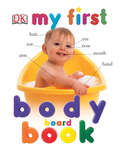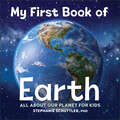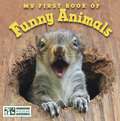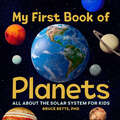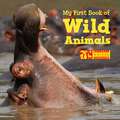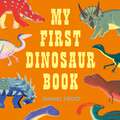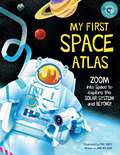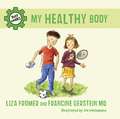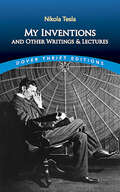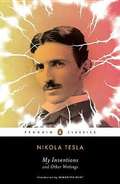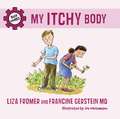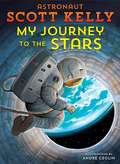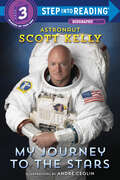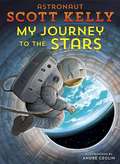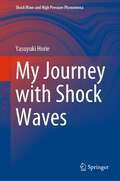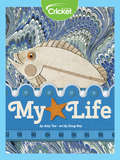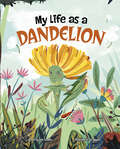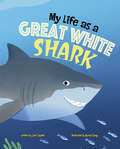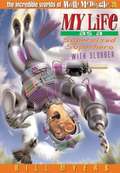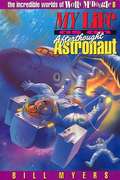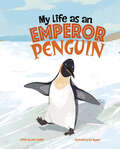- Table View
- List View
My First Body (My First Board Books)
by DKBabies learn to identify parts of the body and their uses with adorable pictures of little ones like themselves in this first word and picture book. Filled with photographs and large, easy-to-read text, My First Board Books provide children with an excellent platform for early learning. A variety of first concepts, such as numbers, letters, and more are introduced in a fun, informative way to help children build the vocabulary and basic language skills that form the foundation of learning.
My First Book About Space: A Question and Answer Book
by Dinah L. MocheA wonderful short children's book about the final frontier: space.
My First Book of Baby Animals (National Wildlife Federation)
by National Wildlife FederationA sweet tiger cub, padding softly on its paws across the ground. A little lion getting its head nuzzled by mama as they soak in the sun. Two young kangaroos—joeys—at play. An infant chimpanzee, clinging lovingly to its mother&’s back. Nothing&’s more irresistible than an animal baby, and with these magnificent photos, kids can meet the cutest ones of all, and their families, too. From two fox kits climbing on logs, to an adorable baby bunny, to a trio of polar bears huddling close to stay warm, to penguins, polar bears, eaglets, and foals, these precious creatures will fascinate human "cubs"—and entice them to look at the pictures over and over again.
My First Book of Earth: All About Our Planet for Kids (My First Book of)
by Stephanie Manka SchuttlerSee how much there is to discover with this Earth science adventure for kids 3-5. From the same series as the popular My First Book of Planets!From the clouds way up above us to the liquid core miles beneath our feet, there are so many amazing things about Earth. See what makes our home planet so special with this introduction to land, sea, and sky for preschool and kindergarten kids. With My First Book of Earth, they'll explore the different continents, how weather works, the important jobs of trees and plants, and so much more!Awesome images—Colorful photos and accurate illustrations show off unbelievable scenery like volcanoes, canyons, and the moon.Why does that happen? —This nonfiction science book for kids explains how rocks are formed, what makes the sun go down at night, and why gravity affects the oceans.Fascinating Earth facts—Did you know that there are mountains underwater? Or that the tallest tree is almost as tall as 19 houses stacked on top of each other? Find trivia like this and more in this amazing Earth book for kids.Pick up this ultimate book of planet Earth and encourage curious kids to read, learn, and explore.
My First Book of Funny Animals (National Wildlife Federation)
by National Wildlife FederationFeaturing spectacular images straight from the vaults of the National Wildlife Federation, these should be the very first books to introduce children to animals from around the world. Every photo shows these creatures in their natural habitats. Each books in the series carries the logo and name of the National Wildlife Federation. These are not just board books, but the first books that any toddler will love and adults will enjoy reading. Each full page spread is a story by itself. See the lions arguing but the walrus can&’t bear to watch. The baby sea lion wants to play and the organgutan wants to play too. The chipmunk tells the polar bear to stop, and the polar bear does. Fantastic photos of wildlife combined with funny comments to make these a new kind of board book.
My First Book of Planets: All About the Solar System for Kids (My First Book of)
by Bruce BettsBlast off on an exploration of outer space with this colorful solar system book for kids 3-5Get little astronomers excited about the cosmos—from the bright and burning sun, to our own blue Earth, stormy Neptune, and every planet in between. With this incredible exploration of planets for preschool and kindergarten kids, curious learners will discover the ultimate solar system book, featuring amazing pictures and fascinating facts about what makes each planet so special, including its size, distance from the sun, what the surface is like, how many moons it has, and more!Go beyond other planet books for kids with:BIG, BEAUTIFUL IMAGES: Vibrant photos and illustrations will take kids deep into space—no telescope required.ASTRONOMY FOR KIDS: Learn all about the eight planets in our solar system, plus dwarf planets Ceres, Pluto, Eris, Haumea, and Makemake.FUN SPACE FACTS: Did you know the bubbles in soda are the same gas that's on Venus? Out of this world facts will make this toddler space book a hit!Show kids the amazing universe that surrounds them with My First Book of Planets.
My First Book of Wild Animals (National Wildlife Federation)
by National Wildlife FederationA snowy owl flying, a giant panda climbing, a huge gray whale emerging from the waves: See these beautiful animals in the wild, where they belong. These amazing photos from the archives of the National Wildlife Federation showcase a menagerie of marvelous creatures. Children will look wide-eyed at a herd of wildebeests rushing through water; a mama brown bear attending to her adorable cubs; a smiling alligator, its powerful jaws opened wide; adult elephants protectively surrounding their young; and more. While enjoying their close-up look at this wonderful world of wildlife, kids will gain an early and lifelong appreciation for the marvelous creatures who also call Earth home.
My First Dinosaur Book
by Daniel FrostMy First Dinosaur Book is the perfect introduction to some of the most roarsome prehistoric creatures, from the scary T.Rex to the gentle Diplodocus.Find out which dinosaurs were the tallest, smallest, biggest or strongest. Which ones stomped over the Earth and which ones soared above it. Packed with fun facts and bright, bold illustrations, this picture book is easily accessible to young readers and perfect for young dino fans who are curious about all things dinosaur!Adapted from Daniel Frost's fun, colourful matching game Find My Behind Dino, children will love this vibrant introduction to some of the most well-loved dinosaurs. Perfect for ages 3+.
My First Human Body Book
by Patricia J. Wynne Donald M. SilverHere's the most entertaining way for children to learn how the human body works: 28 fun and instructive, ready-to-color illustrations that explore the muscular, skeletal, nervous, digestive, respiratory, and immune systems. Kids will discover how their voice box works, how many bones they have, how thousands of "tasters" on their tongues help them distinguish flavors, how the DNA in their cells is different from everyone else's, and so much more. Filled with astonishing details, this head-to-toe survey of the body is fascinating to read and fun to color!
My First Space Atlas: Zoom into Space to Explore the Solar System and Beyond (My First Atlas)
by Jane WilsherLand on the Moon, visit the International Space Station, take a space walk, and tour the planets in this fact-filled guide to the galaxy! Watch out for space junk and black holes! Filled with bright, bold, and scientifically accurate illustrations, fascinating inLayoution, and an interactive "Spot It" game throughout the book, My First Space Atlas will thrill aspiring astronauts and space explorers. FILLED WITH FACTS: Dozens of space facts for curious young space explorers. BOLD ILLUSTRATIONS: Astronauts, rockets, rovers, planets, and more are depicted in bright, colorful illustrations that accurately represent their key features and characteristics. EXPERT AUTHORITY: Created in collaboration with astrophysicist Dr Ben Maughan, My First Space Atlas &“space scientist approved&” and includes all the latest expert inLayoution. READ ALONE OR READ ALOUD: Independent readers will pore over the hundreds of fascinating facts about space, and emerging readers will love learning along with their favorite grown-up. PLAY THE "SPOT IT" GAME: "Can you find the camera on the Moon buggy?", "How many planets are in the Solar System?" There are clues and pictures on every spread to find out all sorts of space inLayoution.
My Healthy Body (Body Works)
by Liza Fromer Francine Joe WeissmannNew book in the BODY WORKS series - straightforward body facts paired with very silly illustrations - for children aged 6 to 9. Ideal for both home and school use. My Healthy Body is a fact-filled book about healthy habits - perfect for instilling the need to look after both mind and body in young children. Covering topics like sleep, exercise, nutrition, vaccines, eye care, social interaction, family, and hygiene this is the perfect go-to-title for general health care for 6 to 9 year olds.
My Inventions and Other Writing and Lectures (Dover Thrift Editions)
by Nikola TeslaThis volume presents one of the richest and most comprehensive collections of writings by Nikolai Tesla, a founding figure of the modern electrical power industry and long-time rival of Thomas Edison. Included is Tesla's autobiography, My Inventions, and the lengthy philosophical essay "The Problem of Increasing Human Energy: With Special Reference to the Harnessing of the Sun's Energy," as well as a series of lectures: "A New System of Alternate Current Motors and Transformers," "On Electricity," and more.
My Inventions and Other Writings
by Nikola TeslaThe fascinating autobiography of the legendary inventor behind the radio, wireless energy, robotics, and much more. Famous for his pioneering contributions to the electronic age, his lifelong feud with Thomas Edison, and his erratic behavior, Nikola Tesla was one of the most brilliant and daring inventors and visionaries of his time. My Inventions is Tesla's autobiography, with meditations on his major discoveries and innovations, including the rotating magnetic field, the magnifying transmitter, and the Tesla coil. This volume also includes three articles by Tesla, as well as an enlightening introduction that discredits many of the myths surrounding the thinker's eccentric life. This rare window into the industrial age's most tragic genius will fascinate historians, scientists, aspiring inventors, and curious fans alike. .
My Inventions: The Autobiography of Nikola Tesla
by Nikola TeslaNikola Tesla has been called the most important man of the twentieth century. Certainly he contributed more to the field of electricity, radio, and television than any other person living or dead. Ultimately he died alone and impoverished having driven all of his friends away through his neurotic and eccentric behavior. Tesla was never able to fit into the world that he found himself in. This autobiography, originally serialized in Electrical Experimenter, is an intensely fascinating glimpse into the mind of a genius, his inventions, and the magical world in which he lived.
My Itchy Body (Body Works)
by Liza Fromer Francine Joe WeissmannA new book in the BODY WORKS series - straightforward body facts paired with very silly illustrations - for children aged 6 to 9. Ideal for both home and school use. My Itchy Body is a fact-filled book about everything that itches: the causes, the cures, the myths, and the reality. Medically accurate information is presented in fun and lively text, and illustrated with a comic touch. Includes fun facts and sidebars, and a glossary.
My Journey to the Stars: Step Into Reading Edition (Step Into Reading Ser.)
by Scott KellyIn this debut autobiographical picture book, celebrated astronaut Scott Kelly describes how he -- and his twin brother -- grew up to achieve his dream of becoming an astronaut.As Scott Kelly prepares to blast back to Earth after a record-breaking year spent on the International Space Station, he thinks about what brought him here and what awaits him at home. Scott's partner-in-crime is his twin brother, Mark. They spent their childhood getting in and out of scrapes. They had a talent for finding trouble and taking risks, which turned out to be great training for the biggest risk of all -- space travel. Along the way to becoming astronauts, they learned to be peacemakers, to stay calm in the toughest of times, to support their family, to work hard and take small steps towards their goals. Scott learned that he needed people to believe in him, as his principal did, even though he was at first a terrible student who couldn't sit still. All of these skills served him well during his year on the ISS, where he and his crew ran 400 experiments and he himself became a test subject. The sacrifices Scott made, the dangers he faced and the sight of our beautiful planet from space made coming home even sweeter.
My Journey to the Stars: Step Into Reading Edition (Step Into Reading Ser.)
by Scott KellyNASA astronaut Scott Kelly makes his Step into Reading debut in this engaging and easy-to-read autobiography that takes readers on his awe-inspiring journey from childhood to his record-breaking year among the stars.A Step 3 Biography Reader of American hero, Astronaut Scott Kelly! Scott wasn't sure what he wanted to be when he grew up. He struggled in school and often got in trouble with his twin brother, Mark. Then one day Scott discovered a book about test pilots and astronauts that set him on a new path.His new focus led him to fly higher and higher, becoming first a pilot and then an astronaut, along with his brother--the first twin astronauts in history. But his greatest accomplishment of all was commanding the International Space Station and spending nearly a year in space, which set the record for the longest spaceflight by an American.This story of an ordinary boy who grew up to do extraordinary things will amaze and inspire young readers.Step 3 Readers feature engaging characters in easy-to-follow plots about popular topics--for children who are ready to read on their own.
My Journey to the Stars: Step Into Reading Edition (Step Into Reading Ser.)
by Scott KellyNASA astronaut Scott Kelly was the first to spend an entire year in space! Discover his awe-inspiring journey in this fascinating picture book memoir (the perfect companion to his adult book Endurance) that takes readers from Scott&’s childhood as an average student to his record-breaking year among the stars. Scott Kelly wasn&’t sure what he wanted to be when he grew up. He struggled in school and often got in trouble with his twin brother, Mark. Then one day Scott discovered a book about test pilots and astronauts that set him on a new path. His new focus led him to fly higher and higher, becoming first a pilot and then an astronaut, along with his brother—the first twin astronauts in history. But his greatest accomplishment of all was commanding the International Space Station and spending nearly a year in space, which set the record for the longest spaceflight by an American. This story of an ordinary boy who grew up to do extraordinary things is perfect for children, fans of Scott's adult book Endurance: A Year in Space, A Lifetime of Discovery, aspiring astronauts, and anyone who has ever tried to defy the odds. It will amaze and inspire you.
My Journey with Shock Waves (Shock Wave and High Pressure Phenomena)
by Yasuyuki HorieThis book compiles historical notes and a review of the work of the author and his associates on shock compression of condensed matter (SCCM). The work includes such topics as foundational aspects of SCCM, thermodynamics, thermodynamics of defects, and plasticity as they relate to shock compression, shock-induced phase transition, and shock compaction. Also included are synthesis of refractory and hard ceramic compounds such as Ni aluminides, SiC and diamonds, method of characteristics, discrete element methods, the shock compression process at the grain scale, and modeling shock-to-detonation transition in high explosives. The book tells the story of how the author’s view of shock physics came to be where it is now. and analytically discusses how the author’s appreciation of shock waves has evolved in time. It offers a personal but pedagogical perspective on SCCM for young scientists and engineers who are starting their careers in the field. For experts it offers materials to nudge them reflect on their own stories, with the hope of planting a seed of motivation to write them down to be published.
My Life
by Amy TaoDid you know a flounder, a type of fish, develops from an egg to a full-grown adult in 2 years? Take a journey through deep waters to see how flounder change and grow to be as much as one foot long.
My Life as a Dandelion (My Life Cycle)
by John SazaklisHi, there! I'm a dandelion. You might see me everywhere, but have you ever stopped to think about how I got there? Learn more about my life cycle and how I went from a tiny little seed to a bold, beautiful flower.
My Life as a Great White Shark (My Life Cycle)
by John SazaklisHi, there! I'm a great white shark. Don't let my sharp teeth scare you off. I started life much smaller, just like you! Learn more about my life cycle and how I went from a tiny little shark pup to the ocean's top predator.
My Life as a Supersized Superhero... with Slobber (The Incredible Worlds of Wally McDoogle #28)
by Bill MyersAt last, Wally can have the superpowers he has always dreamed of and written about! Thanks to the newest invention of Junior Whiz Kid, Wally now has . . Laser-Blaster Eye Beams-handy for catching those bad guys . . . and reheating your hot chocolate. Inviso Shield-a flip of the switch and your invisible . . . except for you're underwear. Extendo Arms-great for back scratching those hard to reach spots . . . particularly if they're a thousand miles away. These and a dozen other superpowers allow him to try to make the world a better place . . . until he realizes that the biggest differences are not made by flashy superheroes, but by everyday people doing everyday acts of kindness.Join our boy blunder as he learns the true meaning of helping and caring for others.
My Life as an Afterthought Astronaut (The Incredible Worlds of Wally McDoogle #8)
by Bill MyersWhen accident-prone Wally McDoogle finds himself a part of a space shuttle mission, he learns a lesson about the importance of obeying the rules.
My Life as an Emperor Penguin (My Life Cycle)
by John SazaklisHi, there! I'm an emperor penguin. I might be the largest penguin on Earth, but I started life much smaller, just like you! Learn more about my life cycle and how I went from an egg to the king of Antarctica.
